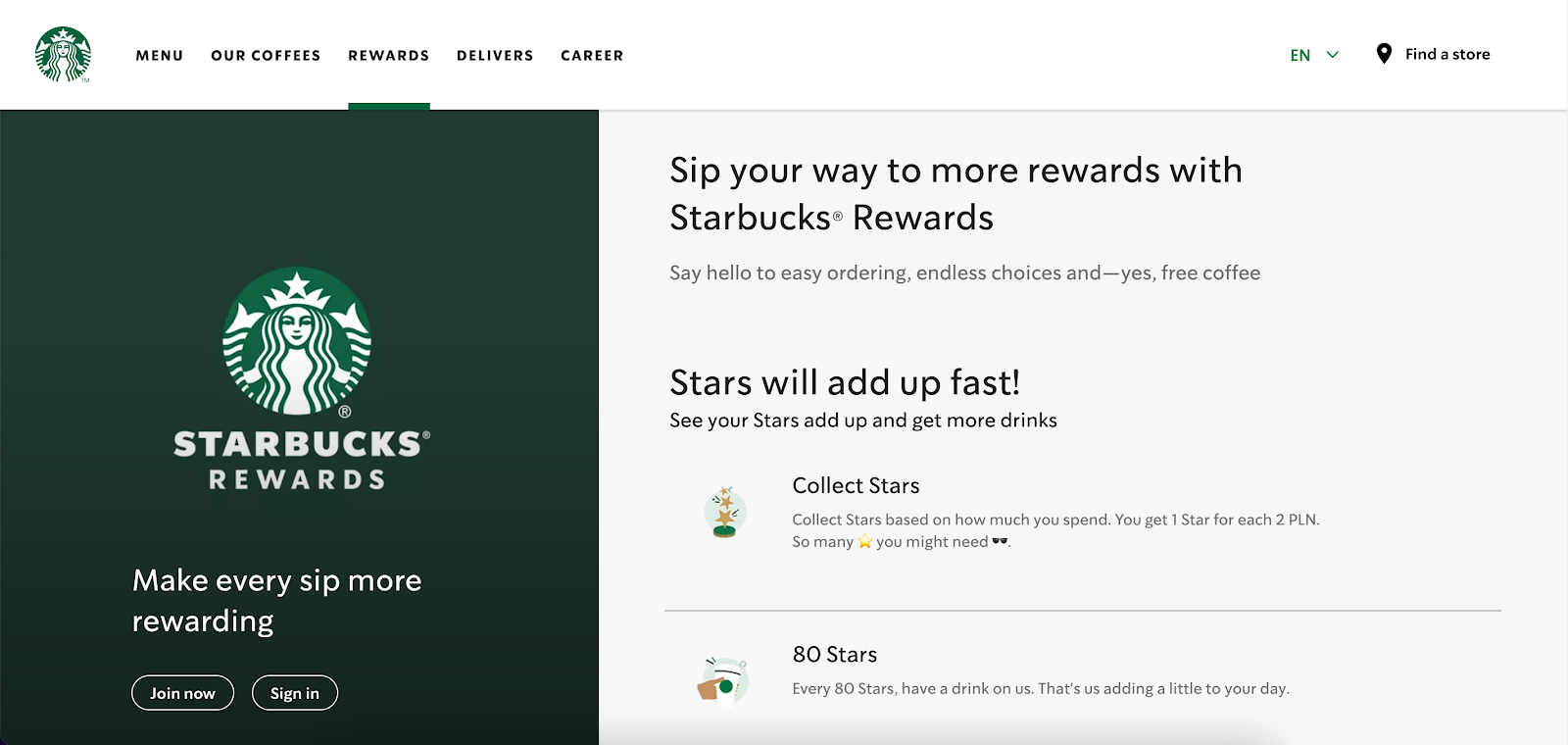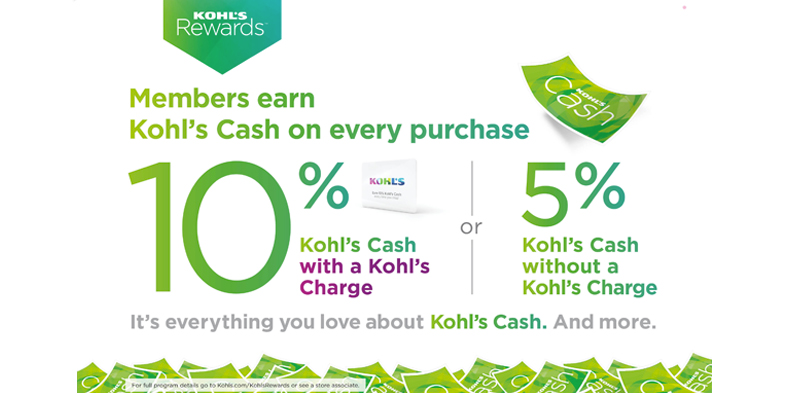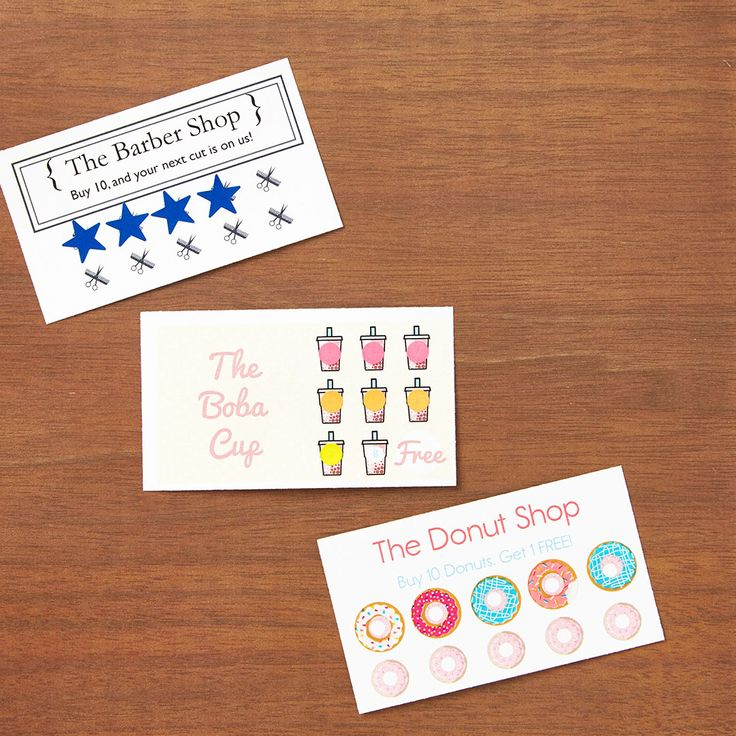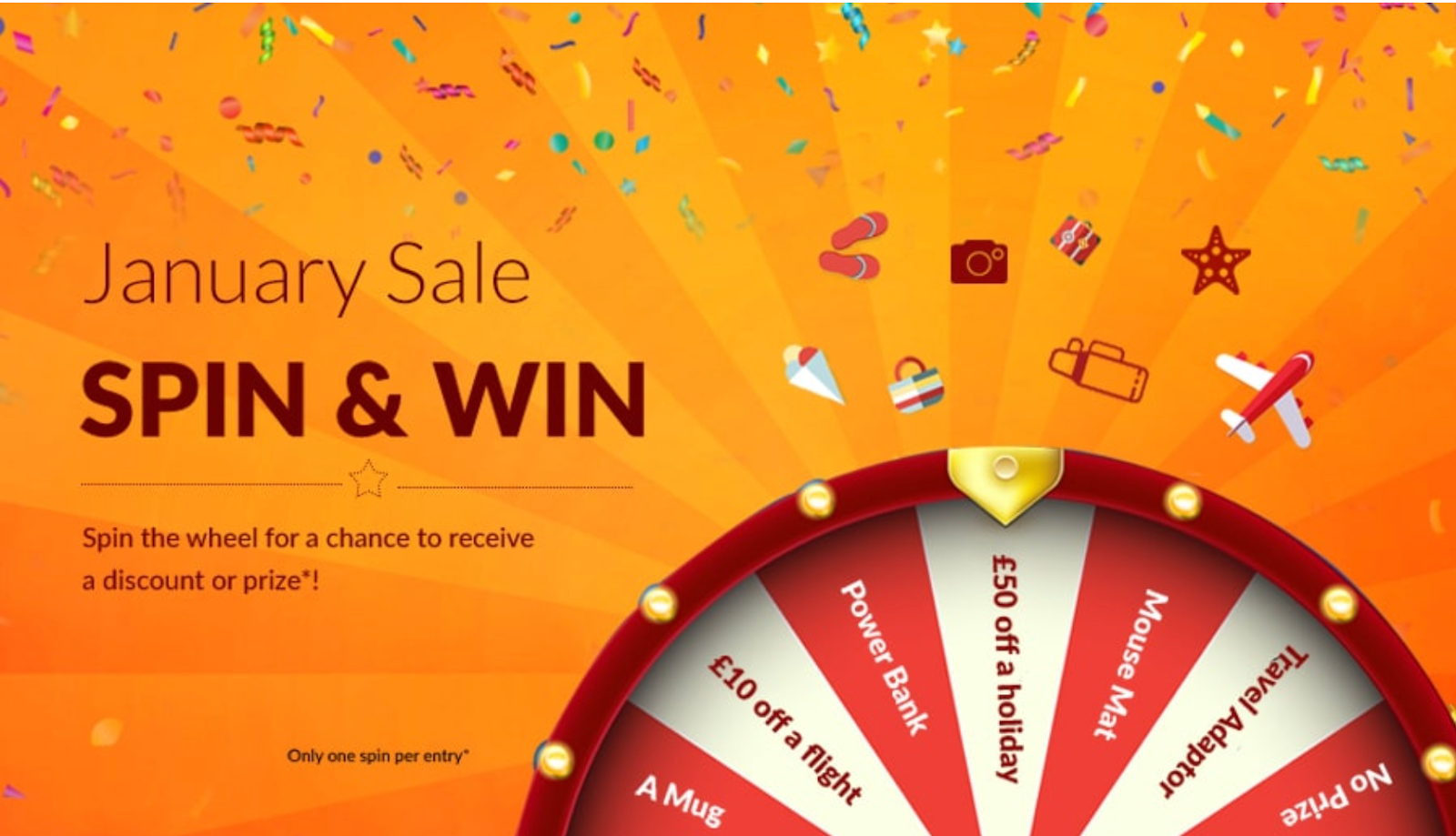From Points to Perks: Understanding Different Types of Loyalty Programs
Loyalty is key to maintaining customer-brand relationships in the face of new competition, evolving tech, and rising customer expectations. 75% of customers prefer brands that reward them, according to Merkle. A well-designed loyalty program can build trust, retain customers, and boost conversions.
This post covers types of loyalty programs and provides tips for creating a successful rewards program.
What is a loyalty program?
Loyalty program is a type of a marketing strategy introduced by brands to retain customers, build customer loyalty, nurture existing customers and attract new ones.
Within each loyalty program there are earning rules – conditions which need to be met in order for a customer to receive rewards in the forms of, for example, points. The collected points then allow for acquiring various types of rewards offered by the brand – among other things the points can be exchanged for a store credit or discount coupons.
Usually, the more the customer is engaged in supporting the brand – the more money they spend on the brand's products – the more rewards they get and are offered better deals.
Benefits of implementing a loyalty program
1. Improving customer retention rate – incentivising your customers through offering them a reward program to participate in will motivate them to choose your brand's products over and over again. Free shipping, tailored discounts, and double-points can be some of the rewards offered within a loyalty program, which will keep your customers satisfied and coming back for more.
2. Collecting important data about customers – when a customer signs up for your loyalty program, your platform can store all sorts of zero- and first-party data associated with their persona such as what products and how often they purchase, what type of cross-sell or up-sale products combos they find appealing, and whether they interact with your brand. When you know more about your customers, you can segment them into groups in order to better tailor rewards for them.
3. Acquire new customers – loyalty programs are not only about retention. Currently, it is also a way to attract new customers through offering, for instance, an initial reward just for signing up. What is more, existing members of a loyalty program can refer their peers to sign up, for which members will get additional points/rewards. It is a double win – your loyal customers are rewarded and potential new customers flow in.
4. Improving sales – when members of a loyalty program participate in special offers and use tailored discounts assigned to them, those activities certainly increase these customers' purchase frequency as well as their cart sizes. The happier the customer, the more loyal to your brand they are. The more loyal they are, the more they buy and you earn more!
Learn more: How to make customers join your loyalty program
9 loyalty program types with pros and cons
There are many ways to reward loyal customers and increase brand loyalty.
1. Point based loyalty programs
A point based program (earn and burn) is arguably the most popular type of a loyalty program within which customers are rewarded with points for each purchase that they make. When a customer reaches a certain number of points, they can get a free product in exchange for points or receive a special discount. As points are assigned individually to each customer, through this loyalty program customers are encouraged to identify themselves while making a purchase, whether online or in store using a loyalty card, which allows the brand to get to know its clients better.
Pros of point based programs:
- Provides a quick and easy incentive for customers to make repeat purchases.
- Can be customized to fit the needs of the business – it is easy to start with the basics and add more program elements as you go.
Cons of point based programs:
- May position your brand as cheap and oriented towards the best value for money, not luxury or unique experiences.
- Can be difficult to track and manage without the right loyalty management software – such programs generate plenty of liabilities if managed incorrectly.
A point based loyalty program is ideal for businesses whose customers have a high purchase frequency and rather specialize in selling commodities as it makes it easy to implement the point system.
Starbucks created a loyalty program within which, after signing up, its customers are granted points named "stars" for performing a particular earning activity. One of such activities is simply spending money on Starbucks' products – in the US, customers earn one point for every dollar that they spend. The earned stars can then be exchanged for various types of rewards such as a free drink.

2. Tiered loyalty programs
Tiered loyalty programs have different levels – tiers – where each tier (standard, VIP, etc.) contains its own set of perks and benefits for customers. Typically, the higher the tier, the better the benefits, so the most committed customers or repeat customers profit the most as their loyalty is rewarded.
A tiered loyalty program is perfect for those businesses which care for building a long-term engagement with customers. In order to move to the next tier, a customer needs to spend a certain amount of money or reach a certain amount of points which can only be done over an extended period of time. Additionally, implementing a tier based system allows for shielding the top-spending members of the loyalty program from competition as they are granted the best benefits.
Pros of tiered loyalty programs:
- Creates a sense of status for customers as they progress through tiers.
- Allows for customization and flexible rewards structure.
Cons of tiered loyalty programs:
- Can be confusing for customers to understand the different tiers and requirements.
- May not provide equal value to all customers, as some may struggle to reach higher tiers – in result it can create dissatisfaction among customers who feel they are not advancing in the program as quickly as they would like.
Sephora runs a Beauty Insider loyalty program, which is a perfect example of a tiered system. Whenever the customer spends a particular amount of money, they move on to the next tier. There are three tiers within the program – Insider to which customers can join freely, VIB to which customers move to when they spend at least $350, and Rouge which opens up for customers who spent $1000 and more.

3. Paid loyalty programs
Paid loyalty programs require customers to pay a recurring fee, for example, every month or once a year, in order to participate in reward programs. The paid loyalty program is typically associated with tiers – the higher the membership fee, the better the benefits.
While it may seem that customers will not be willing to pay in order to participate in a loyalty program, according to Clarus Commerce, 81% of those customers who are signed up to a free loyalty rewards program would be actually willing to upgrade to a paid one if the benefits were valuable and relevant. Typically, fee based loyalty programs' perks are really worth the money as the brands implementing those programs really care about providing high-value rewards to their customers.
Pros of paid membership programs:
- Increases revenue for the business and provide a more stable source of income.
- Leads to increased user engagement, satisfaction, and loyalty.
Cons of paid loyalty programs:
- Non-paying users may not have access to all offerings, leading to potential loss of users and revenue.
- Constant effort is needed to offer new and compelling benefits to retain members and prevent churn.
Costco has a paid membership program – a yearly long subscription – which allows its customers to shop at its brick and mortar shops and also make online orders. There is a Gold Star Membership, Business Membership, and a more exclusive and more expensive Executive Membership which offers the best benefits. Only in 2021, over 111 million people paid for a yearly Costco membership, according to Statista.

Learn more: Paid memberships – can you buy loyalty?
4. Value based (lifestyle) loyalty programs
A value based loyalty program is a unique loyalty program, as it does not offer any explicit rewards such as discount coupons or other tangible perks. Instead, through employing such a program, the business emphasizes its values which, ideally, represent also the customers' values. Such a model of a loyalty program is perfect for which community building is an important entity.
Value based programs allow for establishing a deeper personal relationship between the brand and its customers based on similar personal beliefs. Customers' purchases made within the loyalty program (or collected points) are translated into currency. Then, the particular amount of money or a certain percentage of profits made is transferred to a charity or a welfare program. The organization to which the money is donated can be either chosen by the brand or by customers who are offered a few possibilities.
Pros of value based loyalty models:
- Differentiates the business from competitors and increase market share.
- Increases word of mouth and brand advocacy among high-value customers.
Cons of lifestyle loyalty programs:
- Difficult to maintain – need for legal reviews and transparency.
- Not suitable for most customer groups.
In their current business model, Toms invest 1/3 of their profits into supporting Grassroot Goods, an organization focused on achieving equity, in order to drive a sustainable change. Previously, Toms could be recognised for their "one for one" strategy – for every pairs of shoes bought, one pair of shoes was given to a child in a developing or undeveloped country.

5. Coalition loyalty programs
A coalition loyalty program, also called "shared loyalty program," is a concept where different brands join together in a partnership in order to create the best loyalty offer. Through participating in such a program, customers are provided with a broad variety of incentives, or possible earning actions, offered by business partners. For instance, customers can shop at different stores and still collect loyalty points into one account.
Coalition loyalty programs are especially a great solution for small businesses for which banding together can be profitable, as they can work together in order to achieve customer loyalty. This type of a loyalty program also allows businesses to get to know their customers better, in a broader context. The customer information collected during purchases can be used to personalize loyalty offers and build a better understanding of customers.
Pros of coalition loyalty programs:
- Great option for cross-promotions and building high-value partnerships.
- Larger variety of rewards leads to higher program engagement and satisfaction.
Cons of coalition reward programs:
- Risk of reduced indnvidual brand loyalty.
- Complex program management and administration connected with maintaining brand differentiation.
PAYBACK is a type of a coalition loyalty program which allows its members to earn rewards and discounts from their favorite brands. As PAYBACK is integrated into popular payment methods, customers can gain points through paying for their online orders or chosen products in stores. PAYBACK loyalty points can then be redeemed as e-vouchers or gift cards like Amazon gift card, and many other rewards. As of Germany PAYBACK stands for renowned brands which, among others, are AboutYou, Aral, Apollo-Optik, BAUR, and dm-drogerie markt.

6. Hybrid loyalty programs
A hybrid loyalty program, as the name suggests, is the one in which more than one type of loyalty program is combined. A frequent combination is merging together a loyalty point system with a tiered system. However, it is also possible to combine tiered programs with gamified programs so customers can, for example, move to a new tier, a new level of loyalty, with each level of the game that they complete.
With this type of a loyalty program, flexibility and customisation are guaranteed. As you do not have to stay within the realm of one loyalty program, you can create your own rules that best suit your business and answer the needs of your customer. Employing this method will, at the same time, make your loyalty program unique among others.
Pros of hybrid loyalty programs:
- Plenty of space for flexibility and customization to cherry pick the best elements of individual programs.
- Opportunity to build a creative program model with non-standard rewards and incentives.
Cons of hybrid loyalty programs:
- Customization often comes with higher implementation and operational costs.
- Challenges with accurately tracking and attributing rewards in non-standard program models.
Le Club Drinx's loyalty program is a perfect example of a hybrid loyalty program. It is point based – for every 1€ spend, a customer receives 1 point – but when a certain amount of points is gained, customers can advance to a next tier. There are three tiers within this loyalty program – The Bronze Club to which customers belong after first purchase, The Silver Club which welcomes customers who earned 1000 points, and The Gold Club for those owning at least 2000 points.

7. Cashback loyalty programs
Within cashback loyalty programs, customers receive a particular amount of money for every given dollar amount that they spend. For example, for every $50 that customers spend, they earn $10. Then, they can use the collected money as store credit – use it back on later purchases made within the brand. Cashback programs are a perfect fit for shopping malls, online retailers and fintech companies – their customers are usually the people who value each dollar spent and should welcome a small part of it back with open arms.
Pros of cashback programs:
- Possibility to attract new customers thanks to instant benefits.
- Clear program structure and program membership perks.
Cons of cashback programs:
- Cash is generic – unlike branded loyalty rewards, customers are more likely to stop noticing program benefits after a while.
- Issued with payment mechanisms – customer expect instant cashback which may not always be possible due to technical constraints.
Instead of a given amount of money, customers can receive a particular percentage of their money spent within the purchase. Kohl's adapted such a method in their rewards program. Members earn cash with every purchase – 10% of the amount spent goes into their loyalty account if they use Kohl's Charge card and 5% of the amount if they do not use Kohl's Charge. Then, the collected money is used as store credit.

Cashback loyalty programs can serve as a great incentive for customers and, therefore, facilitate promoting new things. You can personalize your cashback program so your customers can only spend the collected cash on particular products – for example – those that you want to promote. After all, they already bought whatever they needed most and earned themselves a nice discount. Time for exploring the new! Moreover, you can offer the possibility of participating in your cashback loyalty program only to those customers who use your mobile app which will incentivize them to download it and so your mobile app will be promoted too.
Learn more: How to launch a cashback loyalty program?
8. Loyalty punch cards (stamp cards)
Punch cards are a fun way to incentivize customers to buy more frequently at your store. The cards are loyalty business cards which get stamped after every purchase that a customer makes. After a certain number of stamps is collected, a reward is offered – for example, a free product or a free service.
While traditional punch cards are physical and stamped inside stores, currently, many businesses decide to create a system of digital punch cards which can be accessed by customers, for example, via a mobile app.
Pros of loyalty punch cards:
- Very simple implementation and management for brick-and-mortar locations.
- Adjusted to the preferences of older generations of shoppers.
Cons of loyalty punch cards:
- Not fit for ecommerce and digitized services.
- Cumbersome for customers who need to carry the card at all times.
The punch cards can be used by any type of business – a barber shop where a reward for having a full card stamped would be a free haircut, a tea boba shop where customers can be rewarded with a cup of free, personalized drink, or a donut shop where the reward would simply be a free donut. The possibilities are endless!

9. Gamified loyalty programs
Gamified loyalty programs are based on the idea of incentivising customers in an interactive way, for example, through a series of challenges where the goal is to hit an engagement target. Your customer writes a review of your store or a product? They 'win' points. They visit your website as many times as you would like each month? Reward them with points again.
You can also offer your customers a possibility to unlock certain rewards gradually – they need to collect 300 points in order to get a $10 discount. When they earn 500 points, they will be able to get a $25 discount. And so on! Gamification loyalty programs work great when combined with other loyalty programs, for instance, tier based ones - moving from one level to an upper one with bigger discounts to win. That way your customers know that awards are still awaiting them and... they need to shop more to win them.
Additionally, gamification can be introduced into the process of winning rewards themselves. You may create an interactive wheel that your customers virtually spin in your mobile app after reaching a certain amount of points – whatever products it lands on, they win it for free. Or, there can be a set of scratch cards prepared for your customers so they can choose one of, let's say, 4 and virtually scratch & win.
Pros of gamified loyalty programs:
- Gamification increases social sharing and digital engagement.
- Incentivized program membership without the need to offer high-value rewards as the experience is enough in itself.
Cons of gamified loyalty programs:
- High implementation and management costs.
- Need to continually improve the program and add more elements to keep the loyalty game live and kicking.
Brightsun Travel offers their customers a possibility to receive a discount on an upcoming holiday or other special prize in the form of trendy travel merchandise. In order to participate in the game, a customer needs to provide their personal and contact details on the Brightsun Travel website, as there is only one entry to spin the wheel per customer. The spinning wheel is a fun way to incentivise customers to participate in the lottery but also encourage them to sign up into the travel website and become loyal customers.

How to create a successful loyalty program?
1. Offer unique rewards and not random free stuff – as customers grow more demanding nowadays and brands compete for their attention, you need to think of something special to give them – maybe sweepstakes, digital content, or experiences would be good rewards incentivising them to stick to your brand?
2. Keep customers aware of their progress – make sure your customers are able to log into their account and see the number of points that they have as well as what rewards they are eligible for. Send them an email if they move to another tier. Keep them updated so they know where they stand!
3. Reward customers with a gift card instead of a physical product – while getting a free product is a great incentive, you may give a little more freedom to your customers from time to time and let them spend the discount however they want. This will allow you to listen to your customers – see what products they are really interested in and willing to buy.
4. Socialize your reward program – a loyalty program will do no good if no one will know about it. So... Create a social media campaign promoting your rewards program. Incentivise your audience to share posts and links with their friends so your program is promoted.
5. Give your loyalty points a special name – by calling your points, for example, "starts," "miles," "seeds," or "pages," you build a cohesive customer experience, and show that your rewards program is part of your brand community experience, not an afterthought.
6. Thank your consumers before the purchase – send a 'thank you' note to your members of your reward program even before they make a purchase and get points. Interacting with your brand on social media or spending time on your website can constitute earning rules too! Customers will certainly feel appreciated when their interest in your brand is rewarded.
{{EBOOK}}
{{ENDEBOOK}}
Create your next loyalty program with Voucherify
Loyalty programs, whatever their type, are an amazing way to reward customer loyalty, encourage customers to shop more, and bring in new clients. However, in order for a loyalty program to work effectively, you need proper loyalty technology.
At Voucherify, we go hand in hand with loyalty programs and listen to our clients. With our help, you are able to build your own, fully-customized API-first loyalty program that will best suit your brand’s and customers' unique needs.
{{CTA}}
Are you ready to have the best loyalty program in the universe?
{{ENDCTA}}














